Home
Contents Türkic Genetics
In Russian
Roots
Writing
Language
Religion
Geography
Archeology
Coins
Genetics: Lingo-Ethnical Tree
Ethnic Affiliation Scythians
Scythians 7 c. BC
Pazyryk 4-2 c. BC
Burial place of a Massagetan warrior 8-7 c. BC
Besenyos, Ogur and Oguz
Scythians
Alans and Ases
Kipchaks
Kipchaks in Europe
Avar Dateline
Besenyo Dateline
Bulgar Dateline
Huns Dateline
Karluk Dateline
Kipchak Dateline
Khazar Dateline
Kyrgyz Dateline
Sabir Dateline
EASTERN HUNS GENETICS
3 c. BC - 2 c. AD

The authors use the Chinese moniker for the Huns, Xiongnu, in one of the incarnations of its spelling. The dateline of the Eastern Huns and various spellings of their appellations are given in the Huns Dateline. Because the study did not aim to reconstruct the origins of the Huns, but concentrated on the genealogical relationship of the Hun's skeletal remains, only a partial information shedding some light on the origin is in the study. Only the sections that pertain to the Türkic history are cited on this page, for all other elements of the study please refer to the link below. Because nowhere in the article can be found that the cemetery had a sign specifically identifying it as a "Xiongnu cemetery", in the citations I replaced quasi-scientific Xiongnu with its modern widely accepted and uniformly spelled "Eastern Huns" name.
Links
http://www.journals.uchicago.edu/AJHG/journal/issues/v73n2/35013/35013.html
Nuclear and Mitochondrial DNA Analysis of a 2,000-Year-Old Necropolis in the Egyin Gol Valley of Mongolia
mtDNA Analysis
... Although the mtDNA sequences obtained could not be assigned with certainty to mtDNA haplogroups (since they encompassed only the HVI of the control region), three (A, C, and D) of the four major haplogroups observed in Native American (Torroni et al. 1993) and Siberian (Starikovskaya et al. 1998; Schurr et al. 1999) populations were detected in the ancient samples tested (with haplogroup D being the most prevalent). A few sequences belonging to subclusters B4b, D5 or D5a, F1b, J1, G2a, U2 or U5a1a and some that probably belonged to cluster M were also observed (Richards et al. 2000; Yao et al. 2002). No member of the major European cluster H, which occurs in >40% of most European populations (Richards et al. 1996) was found. Interestingly, some of the haplotypes reported here are similar to those found in previous studies of the area (Kolman et al. 1996; Comas et al. 1998).
Discussion
... A majority (89%) of the Eastern Huns' sequences can be classified as belonging to an Asian haplogroup (A, B4b, C, D4, D5 or D5a, or F1b), and nearly 11% belong to European haplogroups (U2, U5a1a, and J1). This finding indicates that the contacts between European and Asian populations were anterior to the Eastern Huns' culture, and it confirms results reported for two samples from an early 3rd century BC Scytho-Siberian population (Clisson et al. 2002).
The genetic data obtained in the present study, in addition to the topographical and radiocarbon data, suggested hypotheses concerning the social history of the necropolis. Around the 3rd century BC, the grave of an adult male (grave 28) had been dug on the southern part of the Egyin Gol valley (A sector). At a short distance from him, a privileged man was also buried (grave 27), as were other individuals, including those found in double graves (graves 32/32A, 33/33A, 37/37A, and 38/38A). Some of these surrounding graves could be sacrificial burials, as has been reported elsewhere for one of them (Murail et al. 2000). This tradition of having double graves near an opulent one in cemeteries containing individuals of high social class is well documented, notably in the Sakka (normally spelled Saka in English, a general endoethnonym of the eastern Scythians - Translator's Note) (another group of nomadic people of the Eurasian steppes) and the Pazyryk cultures (Francfort et al. 2000). This ritual, at the first developmental step of the cemetery, suggests that the cultural influence of the "old Scythian spirit" was already present in some nomadic families at the beginning of the Eastern Huns empire. ...
... (Sometime ca. the 1st c. AD - Translator's Note) ... paternal lineage has been, at least in part (6 of 7 STRs), found in a present-day Turkish individual (Henke et al. 2001). Moreover, the mtDNA sequence shared by four of these paternal relatives (from graves 46, 52, 54, and 57) were also found in a Turkish individuals (Comas et al. 1996), suggesting a possible Turkish origin of these ancient specimens. Two other individuals buried in the B sector (graves 61 and 90) were characterized by mtDNA sequences found in Turkish people (Calafell 1996; Richards et al. 2000). These data might reflect the emergence at the end of the necropolis of a Turkish component in the Eastern Huns tribe.
Footnotes
Source and Comments